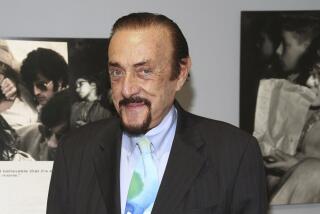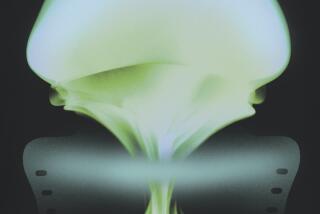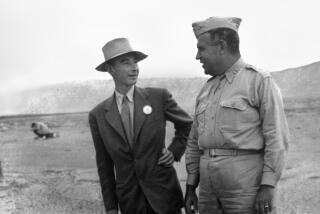Of Quark Hunts, Z-noughts and Dime-Sized Tubes Two Miles Long
We found ourselves on a recent Saturday morning in the amphitheater of the Stanford Linear Accelerator Center, a place on the western edge of the Stanford University campus of rolling hills, well-groomed lawns and gnarled oaks taking the sun. A pool of shimmering pink ice plant marks the guard’s station and the entrance to a quadrangle of office buildings in the boxy style of many California State University campuses.
The center is devoted to the care and feeding of the accelerator, whose public side is a concrete structure two miles long, a cross between the Maginot line and a box that a florist might find useful for very-long-stemmed roses. The private side, where the work is done, is buried 20 feet deep to protect the oaks, the amphitheater and the 1,400 people who work there from the radiation generated when the accelerator is working and the 50 million watts of electricity it pulls from Pacific Gas & Electric Co. transmission lines is hurling atoms at speeds approaching that of light.
Our host was Sidney Drell, a physicist a few months into his 60s, with the square jaw of a boxer, thick spectacles and a rugged face that lights up whether he is talking about the precise world of atomic particles, in which he spends part of his time, or the ragged world of humanity, politics and arms control. His intense involvement in both led him to leadership in an international crusade to free his close friend and fellow-physicist, Andrei D. Sakharov, from banishment for talking back to Soviet leaders on matters of conscience. We were part of a group of two dozen friends who know him as a dogged arms-control advocate and who had come to see what he does when wearing his hat as deputy director of the accelerator and not as co-director of Stanford’s Center for International Security and Arms Control.
He and his colleagues, he told us, stalk quarks, the mysterious and elemental glue that binds together the bits and pieces of the nucleus of the atom, bundles of energy and anti-energy that in turn hold together all of us and everything around us. In earlier phases of the quark hunt, power was poured into a copper tube the size of a dime that runs the length of the linear accelerator so electrons could ride the power surges like “surfers on a wave,” as Drell put it, calling on a gift for simile that is the only window many of us have on the science he practices.
At the end of the two-mile ride through the accelerator’s dime-sized tube, the surfers smash against a target and break apart in a concrete pillbox packed with instruments that record the resulting debris so that researchers can scroll through computers later and determine what had been hurled out of the nuclei.
Over time, the power pumped into the copper tube has become so great that Einstein’s formula, E = mc 2, has come into play. Energy’s conversion into mass meant the electron surfers weighed 100,000 times as much at the end of their two-mile ride as at the start, and instead of smashing atoms they squashed them. “It was like a collision between a Mack truck and a Volkswagen,” Drell said, a turn of events not useful to quark hunters. To get beyond that phase, Drell and his colleagues built a small loop at the end of the tube so that the accelerator took on the shape of the dime-store gadgets children use to blow soap bubbles. Electrons now surf down the accelerator’s copper tube and flow one way when they get to the loop; positrons ride along with them and flow the other. When they meet at the halfway point, and the inevitable collision occurs, Einstein’s principle has turned both into Mack trucks.
The center is now building its third, still larger, loop to move physics closer to its goal of breaking apart the smaller segments of the nucleus instead of simply squashing them. If theoretical physicists are right, debris from future collisions should produce tens of thousands of a fragment, a heavy force, buried in atoms that physicists call the Z-nought, of which a few dozen have splattered into the accelerator’s instruments during the quark hunt that began when the accelerator smashed its first atom in the early 1960s. The hope is that the fragments may be the missing link between the properties of gravity and electromagnetism that physicists believe, but have yet to demonstrate empirically, are related.
“That is our Holy Grail,” Drell said, “the unifying theory of physics.” With thousands of Z-noughts to examine rather than dozens, Drell said, “we would be close to explaining what happened in the Big Bang”--the explosion of energy that physicists believe created the universe of which earth is but a particle and the breathtaking pool of pink ice plant a mere sub-particle. “We won’t be able to tell you what happened in the instant before the Big Bang,” he said. “That we must leave to the theologians. But we could lay it all out after that instant.”
Because the Big Bang may be certified by doing no more than adding one loop to the accelerator, only a physicist could imagine what further clues to the universe might be found in the debris of the 53-mile ring of a superconducting super-collider that, when built, would hurl atomic surfers at one another on waves of power an order of magnitude above those at Stanford.
We left the amphitheater and boarded a green school bus with federal license plates, one of the few signs that the center is also a particle of the universe of the U.S. Department of Energy, which finances the accelerator’s search for more Z-noughts and other atomic debris. The bus stopped at an observation point along the accelerator, where we got an inkling of what Drell meant a few years ago when he challenged the Pentagon’s blithe assertions that President Reagan’s search for a shield to protect the United States from nuclear missiles would be a piece of cake, that it could be assembled in space and then counted on to work perfectly the first time without a dry run. “I have to cross my fingers every time we turn on the accelerator,” he had said, “and compared to the Strategic Defense Initiative, the accelerator is a very simple piece of machinery.” What he meant was: In order to create a proper collision between electrons and positrons in the accelerator, the system must be calibrated to such microscopic tolerances that the electron surfers riding their power waves cannot slide one way or the other more than one-millionth of a centimeter during their two-mile ride.
Tour over, we stepped out of a shed, perhaps a shade smaller than Houston’s Astrodome, that houses the newest set of massive electromagnets that will catch the debris of exploding atomic nuclei in the third loop. Back among the foothills bathed in sunshine and cluttered with construction machinery, we watched a hawk, wings stiff, carve lazy circles in the cloudless sky; still a thing of wonder but, fresh from the world of Sid Drell, no longer a mere hawk but a bundle of raw energy held together by quarks.
Later, at a picnic table under a gnarled oak outside the amphitheater, we talked about “Star Wars,” the quest for more Z-noughts and Sakharov. Drell, who left the public schools of Atlantic City where he was born and went to Princeton planning to major in classics until he fell under the spell of a physics professor, was waiting for a visa that would allow him to travel to Moscow this weekend for a reunion with Sakharov, whom he first met in 1974. They had stayed in touch, even after Sakharov’s exile to Gorky, from which the Soviet physicist had smuggled out a 24-page paper discussing theories of the origin of the universe, a paper that reached Drell shortly before Sakharov’s 1984 hunger strike. If Drell’s world of subnuclear particles seems small, consider a world in which theories smuggled to Drell from Gorky are being tested at the Stanford accelerator.
We returned to hawks and how they and pink ice plant would never look quite the same, and talked about Drell’s description of the fascinations of particle physics: “You’ll never know all the answers, but how can you stop looking?” At the mention of the hawk, Drell grinned. “I wish it had been a dove,” he said.






